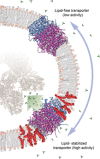A new window into the molecular physiology of membrane proteins
- PMID: 25630257
- PMCID: PMC4303381
- DOI: 10.1113/jphysiol.2014.283150
A new window into the molecular physiology of membrane proteins
Abstract
Integral membrane proteins comprise ∼25% of the human proteome. Yet, our understanding of their molecular physiology is still in its infancy. This can be attributed to two factors: the experimental challenges that arise from the difficult chemical nature of membrane proteins, and the unclear relationship between their activity and their native environment. New approaches are therefore required to address these challenges. Recent developments in mass spectrometry have shown that it is possible to study membrane proteins in a solvent-free environment and provide detailed insights into complex interactions, ligand binding and folding processes. Interestingly, not only detergent micelles but also lipid bilayer nanodiscs or bicelles can serve as a means for the gentle desolvation of membrane proteins in the gas phase. In this manner, as well as by direct addition of lipids, it is possible to study the effects of different membrane components on the structure and function of the protein components allowing us to add functional data to the least accessible part of the proteome.
© 2014 The Authors. The Journal of Physiology © 2014 The Physiological Society.
Figures


Comment in
-
Lipids Can Make Them Stick Together.Trends Biochem Sci. 2017 May;42(5):329-330. doi: 10.1016/j.tibs.2017.03.001. Epub 2017 Mar 28. Trends Biochem Sci. 2017. PMID: 28363673
References
-
- Anderson RG. Jacobson K. A role for lipid shells in targeting proteins to caveolae, rafts, and other lipid domains. Science. 2002;296:1821–1825. - PubMed
-
- Barrera NP, Di Bartolo N, Booth PJ. Robinson CV. Micelles protect membrane complexes from solution to vacuum. Science. 2008;321:243–246. - PubMed
-
- Barrera NP. Robinson CV. Advances in the mass spectrometry of membrane proteins: from individual proteins to intact complexes. Annu Rev Biochem. 2011;80:247–271. - PubMed
Publication types
MeSH terms
Substances
Grants and funding
LinkOut - more resources
Full Text Sources
Other Literature Sources

